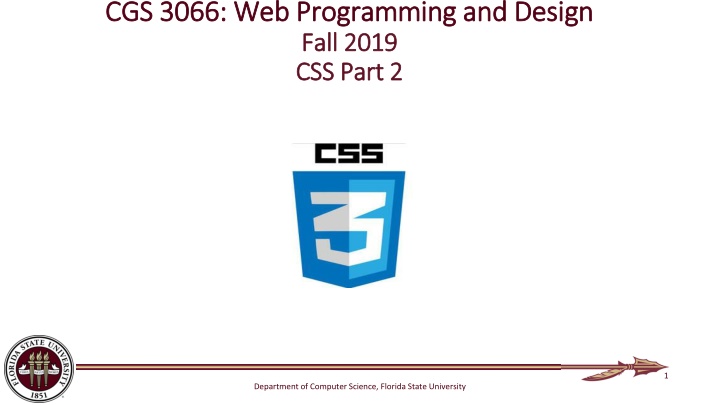
CSS Box Model for Web Design
Learn about the CSS box model which includes content area, padding, border, and margin. Discover how to set width and height properties, as well as shorthand techniques for padding and margin in web design.
Download Presentation

Please find below an Image/Link to download the presentation.
The content on the website is provided AS IS for your information and personal use only. It may not be sold, licensed, or shared on other websites without obtaining consent from the author. If you encounter any issues during the download, it is possible that the publisher has removed the file from their server.
You are allowed to download the files provided on this website for personal or commercial use, subject to the condition that they are used lawfully. All files are the property of their respective owners.
The content on the website is provided AS IS for your information and personal use only. It may not be sold, licensed, or shared on other websites without obtaining consent from the author.
E N D
Presentation Transcript
CGS 3066: Web Programming and Design CGS 3066: Web Programming and Design Fall 2019 Fall 2019 CSS Part 2 CSS Part 2 1 Department of Computer Science, Florida State University
The CSS Box Model All printable HTML elements can be represented as rectangular boxes Each box consist of the following spaces: Content Area: displays the actual text/graphic Padding: spaces surrounding the content area Border: Surrounds contents and padding Margin: spaces to separate an element from other adjacent elements or its container
The CSS Box Model Margin Border Padding Content
The CSS containing element Each element has an associated containing element each box sits inside some bigger box Only block level elements(<div>,<table>,<h1>..<h6> etc) or the webpage itself(<html> tag) are considered as containing element In case of multiple block-level nesting, the containing element of a box/element will be the closest block level element Will be referred as simply container
CSS Widthand heightproperties height: [length units] width: [length units] Used to set width and height of the Content Area of an Element div{ height: 100px; width: 300px; } Length values can be absolute(in,cm,mm,px) or % of the height/width of its container
CSS Padding properties padding-top: [length units] padding-right:[length units] padding-bottom:[length units] padding-left:[length units] Shorthand expression: padding: [top][right][bottom][left] Start from top and go clockwise
Shorthand format Typing out all of these properties out can be tiresome, so CSS provides an alternative shorthand form of the padding property that lets you set the top/bottom and left/right padding with only one line of CSS. p { padding: 20px 10px; } Vertical Horizontal
CSS Margin properties margin-top: [length units] margin-right:[length units] margin-bottom:[length units] margin-left:[length units] Similar to padding, property margin can set all 4 values in top-right-bottom-left sequence
CSS Borders border-style: [none/hidden/dotted/dashed/solid/double/groove/ridge/inset/outset] To Add style to specific side of a border: border-top-style,border-bottom-style .. border-color: [color value] Similarly, border-top-color, border-left-color etc. border-width: [length units] Applies uniform width to all four borders. Customizable Shorthand expression: border: [border-width value] [border-style value] [border-color value]
CSS Borders h1 { border: 1px solid red; } And this one creates a thick, dotted green border: Heading h1 { border: 4px dotted green; } Heading
CSS Borders border-collapse: [collapse/separate] Applies to Table elements If separate, adjacent cells each have their own distinct borders. If collapsed, adjacent table cells share borders.
Default HTML Layout By default, all visible elements of a web page is displayed in the same sequence they are written in HTML Page width filled from left to right, then height filled from top to bottom
HTML vs CSS Positioning How to design multi-column layouts on a web page? Use <table> Add content blocks as table data not recommended Alternatively, use CSS positioning properties
CSS float Property float: [left/right/none] Places the selected element at the left or right side of its container Other texts and inline elements of the container will wrap around it Widely used
CSS float Property By default, block-level elements occupy the entire available width of its container Try printing a small <div> with a background color! Replace <div> with <span> and compare! To make the block level elements float, it should be shrunk by setting appropriate width property
CSS float Property #div1 { float:right; width:300px; height:300px; background-color:red; border-style:solid" } <p id= para1 > <div id= div1 > floated<br>text</div> Loren ipsum . laborum </p>
CSS clear Property clear: [left/right/both] Prevents placement of floating element on the [left/right/both] side of the selected element Useful to clear past floating elements and resume normal flow
CSS clear Property #para2{ clear:both; border-style:solid; border-color:blue } <p id= para1 > <div id= div1 > floated<br>text</div> Loren ipsum . Pariatur <p id= para2 > Instead of it s right </p> </p>
CSS position property position: [static|absolute|fixed|relative] Position value static suggests default, normal flow. To use absolute/fixed/relative option, one or two of the following must be set: top: [length units] bottom: [length units] left: [length units] right: [length units] Specifies exact placement location for the selected element
CSS position property(contd.) absolute: Positioning values measured from the edge of the entire HTML document fixed: Positioning values are calculated from the edge of the viewport. User always sees a fixed element in the same location of his page view Relative: Positioning values are calculated from the edges of the nearest positioned container Example: http://learnlayout.com/position-example.html
